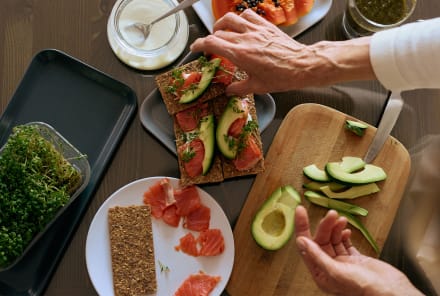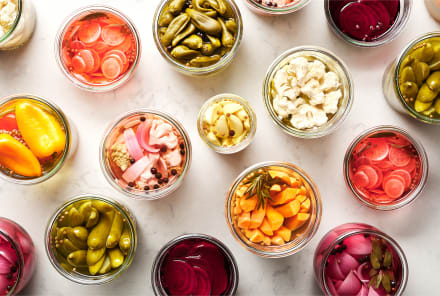Advertisement
5 Anti-Inflammatory Foods To Eat For A Younger, Healthier Brain


Aging may be inevitable, but its negative side effects don't have to be. Eating the right foods can significantly decrease your risk of developing neurological problems, improve your mental health, and help you stay sharp and focused as you get older.
As a nutritional psychiatrist, these are the top five "anti-aging" foods I recommend to help protect your brain from damage over time. How will you get more of these "B-O-G-O-S" onto your plate today?
Berries & colorful veggies (B)
Inflammation in the gut loops back to the brain, potentially leading to neurocognitive decline1. Consuming fiber-rich foods like fruits and vegetables, especially of different colors (which provide a diverse set of vitamins, polyphenols, and flavonoids), can be a great way to keep your brain sharp as you grow older.
Rich in fiber, antioxidants, and vitamins, berries support a healthy microbiome2 and can reduce inflammation3. Blueberries specifically contain one of the highest concentrations of mental health-supporting anthocyanin4, a powerful antioxidant that supports brain health and memory with age.
Colorful veggies, like red peppers, also contain phytonutrients and fiber and positively interact with gut microbes, which reduce inflammation in the body when we feed and nourish them well.
Olive oil (O)
Extra-virgin olive oil is anti-inflammatory5 and rich in antioxidants to support autophagy6 (cellular repair). Olive oil is also a source of at least 30 phenolic compounds, such as oleuropein, oleocanthal, hydroxytyrosol, and tyrosol—all of which act as strong antioxidants and brain protectors. Populations that consume more olive oil have fewer incidences of Alzheimer's7, according to research.
Greens (G)
Loaded with vitamins, minerals, and fiber, leafy greens like Swiss chard, dandelion greens, romaine lettuce, arugula, and spinach are especially high in folate, which is associated with healthy brain development and a reduced risk of depression. Long-term folate deficiency8 has also been associated with several neurological conditions. Thus, getting enough folate with leafy greens has a positive benefit on both cognitive aging and brain health.
Folate is important for brain health because it helps to maintain myelin, a fatty substance that protects nerve endings, and supports the production of neurotransmitters that are essential for maintaining a positive mindset.
Omega-3s (O)
Did you know that the brain is made primarily of fat, and it relies on an abundance of healthy fats in the diet to maintain its integrity and function? Wild sockeye salmon, anchovies, and sardines are prime sources of omega-3 fatty acids called EPA and DHA, which are important for brain health.
Omega-3s promote brain health by lowering inflammatory markers and protecting neurons from excessive inflammation. Chia, flax, and hemp seeds and walnuts also provide omega-3s, though in a less bioavailable form.
Spices (S)
No brain food kitchen is complete without an abundance of herbs and spices! Not only do these add incredible flavor to foods, but they are full of bioactive compounds with cognition-boosting benefits.
For example, the antioxidant, anti-inflammatory, and neurotropic effects of turmeric can improve mood and brain health. (Have you tried my favorite mood-boosting golden milk latte yet?) Saffron has also been found to have strong antidepressant effects9 on individuals with low mood. Similarly, cayenne pepper is known to improve energy levels10, while ginger and chamomile can reduce stress.
Enjoying fresh herbs like sage and rosemary, which are rich in antioxidants, also helps to reduce neuro-inflammation and support a mood boost.
The takeaway
It's never too early (or too late) to introduce more brain-healthy foods into your routine. Berries, olive oil, greens, omega-3s, and spices ("BOGOS") are the ingredient categories I recommend to anyone looking to keep their brain in tiptop shape as the years go by.
10 Sources
- https://www.frontiersin.org/articles/10.3389/fnagi.2023.1162057/f
- https://pubmed.ncbi.nlm.nih.gov/36834497/
- https://pubmed.ncbi.nlm.nih.gov/24512603/
- https://pubmed.ncbi.nlm.nih.gov/31329250/
- https://www.ncbi.nlm.nih.gov/pmc/articles/PMC6825477/
- https://pubmed.ncbi.nlm.nih.gov/28812046/
- https://pubmed.ncbi.nlm.nih.gov/31521394/
- https://www.sciencedirect.com/science/article/abs/pii/S095528632300061X
- https://pubmed.ncbi.nlm.nih.gov/25384672/
- https://pubmed.ncbi.nlm.nih.gov/27775591/
Watch Next
Enjoy some of our favorite clips from classes
Enjoy some of our favorite clips from classes
What Is Meditation?
Mindfulness/Spirituality | Light Watkins
Box Breathing
Mindfulness/Spirituality | Gwen Dittmar
What Breathwork Can Address
Mindfulness/Spirituality | Gwen Dittmar
The 8 Limbs of Yoga - What is Asana?
Yoga | Caley Alyssa
Two Standing Postures to Open Up Tight Hips
Yoga | Caley Alyssa
How Plants Can Optimize Athletic Performance
Nutrition | Rich Roll
What to Eat Before a Workout
Nutrition | Rich Roll
How Ayurveda Helps Us Navigate Modern Life
Nutrition | Sahara Rose
Messages About Love & Relationships
Love & Relationships | Esther Perel
Love Languages
Love & Relationships | Esther Perel


















